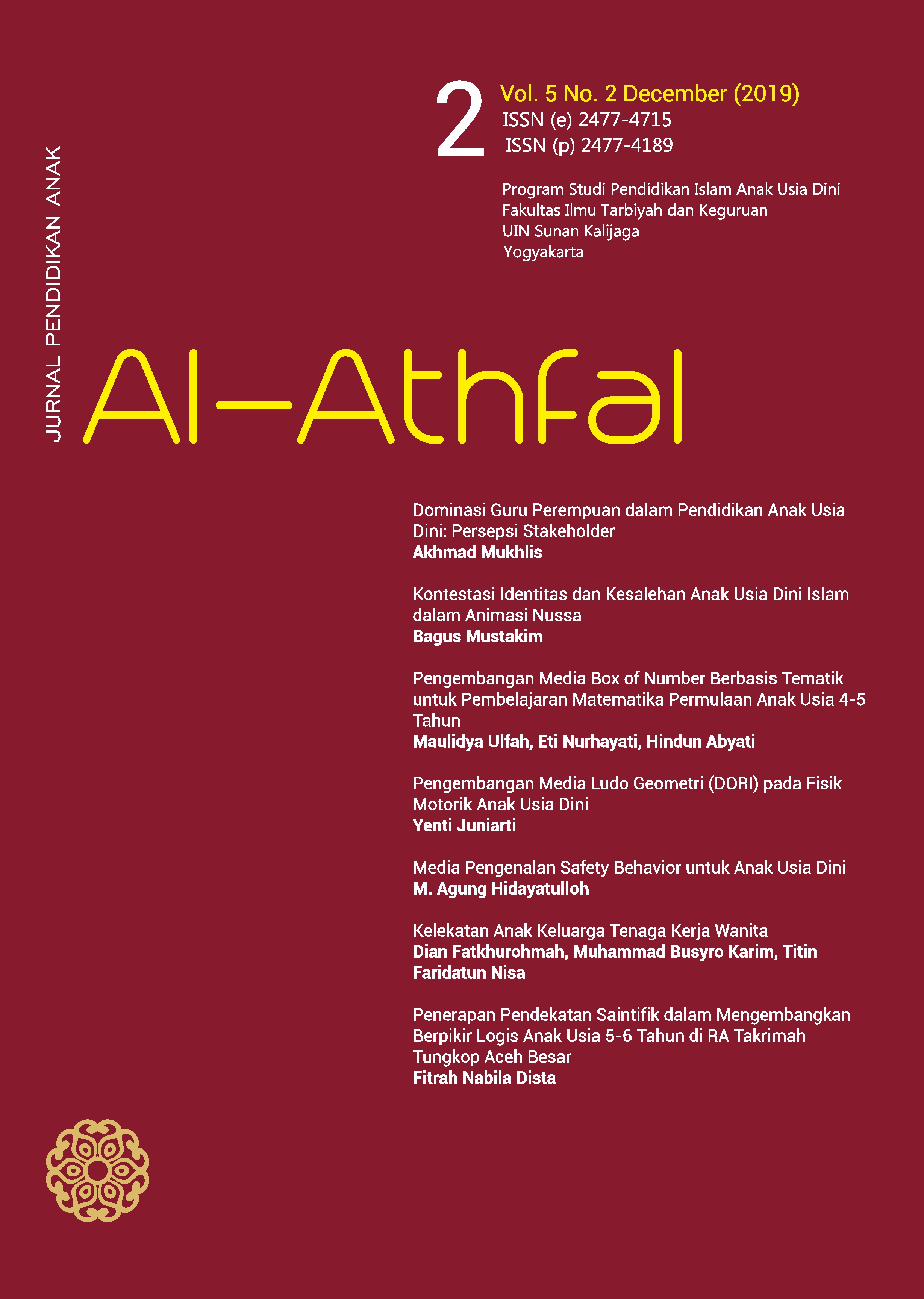970
Views
1373
Downloads
 Open Access
Open Access
Pembelajaran PAKEM Berbasis Media Audio Visual Gerak dalam Melatih Konsentrasi Belajar Anak di TPA Sahabat Hati Pontianak
Main Article Content
Abstract
Early age is an important age to influence subsequent developments. Early childhood is a period of play as a way of learning children. One model of learning in early childhood is PAKEM learning (Active, Creative, Effective and Enjoyable Learning). The purpose of this study is to present PAKEM learning based on audio-visual motion media in training children's learning concentration. The method used is qualitative descriptive with data collection techniques in the form of interviews, observation and documentation. In analyzing the data, it used the Miles and Huberman model. The validity test of the data used source and technique triangulation. The results showed that PAKEM learning based on audio visual motion in the TPA Sahabat Hati was carried out through several stages, namely, planning, implementation and evaluation. The implementation is an initial activity, core and closing. Audio visual motion is displayed via television which is arranged according to the learning schedule. Children then are active to see, hear and follow their movements directly. Thus, PAKEM learning based on audio-visual motion media at the TPA Sahabat Hati is effective in training children's learning concentration.
Keywords:
Downloads
Article Details
How to Cite
Copyright
Authors who publish with this journal agree to the following terms:
- Authors retain copyright and grant the journal the right of first publication with the work simultaneously licensed under a Creative Commons Attribution License that allows others to share the work with an acknowledgment of the work's authorship and initial publication in this journal.
- Authors can enter into separate, additional contractual arrangements for the non-exclusive distribution of the journal's published version of the work (e.g., post it to an institutional repository or publish it in a book), with an acknowledgment of its initial publication in this journal.
- Authors are permitted and encouraged to post their work online (e.g., in institutional repositories or on their website) before and during the submission process. It can lead to productive exchanges and earlier and greater citation of published work.
References
Alfiani, D. A. (2016). Penerapan Model Pembelajaran SAVI (Somatis, Auditori, Visual, Intelektual) Terhadap Hasil Belajar Aanak Usia Dini. Awlady : Jurnal Pendidikan Anak, 2(1). https://doi.org/10.24235/Awlady.V2I1.763
Antika, R. R. (2014). Proses Pembelajaran Berbasis Student Centered Learning (Studi Deskriptif di Sekolah Menengah Pertama Islam Baitul ‘Izzah, Nganjuk). BioKultur2, 3(1). Retrieved from http://journal.unair.ac.id/BK@proses-pembelajaran-berbasis-student-centered-learning-(studi-deskriptif-di-sekolah-menengah-pertama-islam-baitul-‘izzah,-nganjuk)-article-8612-media-133-category-8.html
Arriani, F. (2014). Perilaku Agresif Anak Usia Dini. Jurnal Pendidikan Usia Dini, 8(2), 263–274. Retrieved from http://journal.unj.ac.id/unj/index.php/jpud/article/view/3589
Arsyad, A. (2009). Media Pembelajaran. Jakarta: Rajawali Press.
Asmani, J. M. (2014). 7 Tips Aplikasi PAKEM. Yogyakarta: Diva Press.
Astuti, E. S., Wahyuningsri, & Warastuti, W. (2014). Pengaruh Stimulasi Motorik Halus terhadap Daya Konsentrasi Belajar Anak Usia Prasekolah. Jurnal Ilmu Pendidikan, 20(2). https://doi.org/10.17977/JIP.V20I2.4621
Daryanto, & T. (2012). Konsep Pembelajaran Kreatif. Yogyakarta: Gava Media.
Didi Pianda, Jon Darmawan, dkk. (2018). Best Practice Karya Guru Inovatif (Menarik Perhatian Peserta Didik). (D. Pianda, Ed.). Jawa Barat: CV Jejak Publisher.
Fadlillah, D. (2014). Edutaiment Pendidikan Anak Usia Dini (Menciptakan Pembelajaran Aktif, Kreatif, dan Menyenangkan). Jakarta: Kencana Prenada Media Group.
Hartati, S. (2005). Perkembangan Belajar pada Anak Usia Dini. Jakarta: Departemen Pendidikan Nasional.
Kamus Besar Bahasa Indonesia. (1998). Jakarta: Departemen Pendidikan dan Kebudayaan.
Linschoten, J, & M. (1983). Pengantar Ilmu Jiwa. Bandung: Jemmars.
Nawawi, I. (1999). Terjemahan Riyadhus Shalihin Jilid 1. Jakarta: Pustaka Amani.
Nuha, U. (2016). Ragam Metodologi & Media Pembelajaran Bahasa Arab. Yogyakarta: Diva Press.
Nur, H. (2013). Membangun Karakter Anak Melalui Permainan Anak Tradisional. Jurnal Pendidikan Karakter, 0(1). https://doi.org/10.21831/JPK.V0I1.1290
Purwanto, M. N. (2017). Psikologi Pendidikan. Bandung: Remaja Rosdakarya. Retrieved from https://rosda.co.id/pendidikan-keguruan/413-psikologi-pendidikan-ngalim.html
Putra Made, Komang Dewi Sukaryasih, N. N. G. (2016). Penerapan Model PAKEM Berbantuan Alat Permainan Edukatif Plastisin Untuk Meningkatkan Kemandirian Anak. Jurnal Pendidikan Anak Usia Dini Undiksha, 4(1). Retrieved from https://ejournal.undiksha.ac.id/index.php/JJPAUD/article/view/7311
Rahmawati, D. A. (2014). Perbandingan Tingkat Konsentrasi Belajar Anak Sekolah Dasar dari Kebiasaan Makan Gizi. BELIA: Early Childhood Education Papers (Vol. 3). Retrieved from https://journal.unnes.ac.id/sju/index.php/belia/article/view/3418
Sadirman, A. S. dkk. (2003). Media Pendidikan. Jakarta: PT Raja Grafindo Persada.
Sudijono, A. (2007). Pengantar Evaluasi Pendidikan Edisi 7. Jakarta: Raja Grafindo Persada.
Tabrani, R. (1998). Pendekatan dalam Proses Belajar Mengajar. Bandung: Remaja Rosda Karya.
Tri, R. (2010). Mengenal Hadis Bersama Upin dan Ipin (Mudah Menghafal dan Mengenal Hadis). Bandung: Mizan Pustaka.
Usmani, A. R. (2009). Mutiara Riyadhushshalihi, diterjemahkan dan Diikhtisarkan dari Riyadh Al-Shalihin Karya Imam Abu Zakariyya Yahya bin Syaraf Al-Nawawi Al-Dimasyqi, Bairul: Dar Al-Fikr, 1994. Bandung: Mizan Pustaka.




